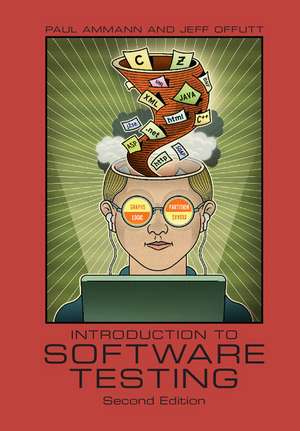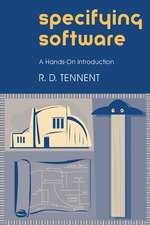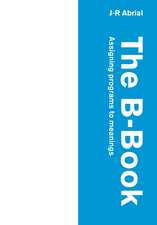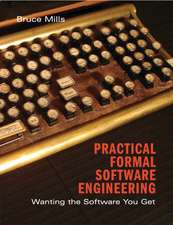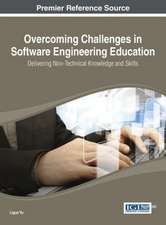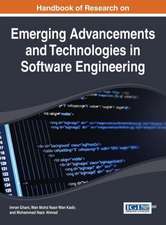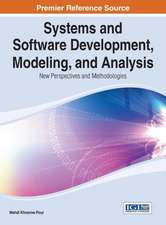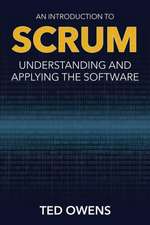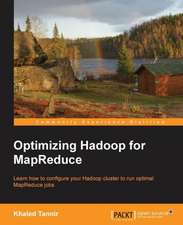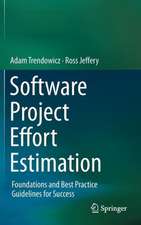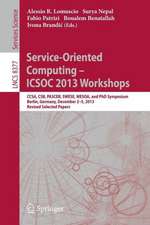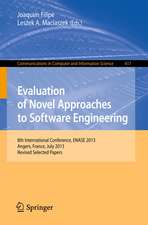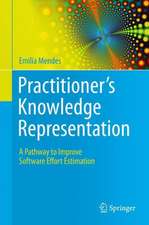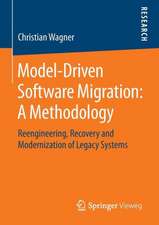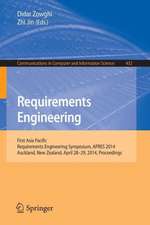Introduction to Software Testing
Autor Paul Ammann, Jeff Offutten Limba Engleză Hardback – 12 dec 2016
Preț: 425.03 lei
Preț vechi: 531.29 lei
-20% Nou
Puncte Express: 638
Preț estimativ în valută:
81.34€ • 88.32$ • 68.32£
81.34€ • 88.32$ • 68.32£
Carte tipărită la comandă
Livrare economică 22 aprilie-06 mai
Preluare comenzi: 021 569.72.76
Specificații
ISBN-13: 9781107172012
ISBN-10: 1107172012
Pagini: 364
Ilustrații: 79 b/w illus.
Dimensiuni: 184 x 260 x 50 mm
Greutate: 0.93 kg
Ediția:2Revizuită
Editura: Cambridge University Press
Colecția Cambridge University Press
Locul publicării:New York, United States
ISBN-10: 1107172012
Pagini: 364
Ilustrații: 79 b/w illus.
Dimensiuni: 184 x 260 x 50 mm
Greutate: 0.93 kg
Ediția:2Revizuită
Editura: Cambridge University Press
Colecția Cambridge University Press
Locul publicării:New York, United States
Cuprins
Preface; Part I. Foundations: 1. Why do we test software?; 2. Model-driven test design; 3. Test automation; 4. Putting testing first; 5. Criteria-based test design; Part II. Coverage Criteria: 6. Input space partitioning; 7. Graph coverage; 8. Logic coverage; 9. Syntax-based testing; Part III. Testing in Practice: 10. Managing the test process; 11. Writing test plans; 12. Test implementation; 13. Regression testing for evolving software; 14. Writing effective test oracles; List of criteria.
Recenzii
Review of the first edition: 'I think this is a great testing book, both from academic and industrial perspectives. I believe Ammann and Offutt's book will become the testing textbook of choice. There are a lot of testing books out there, some better than others. Most are narrow in the topics they cover and the level of detail they present. In stark contrast, Ammann and Offutt's book has the advantage of presenting concepts and techniques that cover the broad range of languages and platforms used in practice by industry and academia. Theirs is one of the most thorough and practical testing books ever published.' Roger Alexander, Washington State University
Review of the first edition: '… well written, logically organized, and provides excellent examples as well as useful course materials (such as homework assignments and quizzes) … greatly facilitates the teaching and learning process. I plan to … use the Ammann and Offutt text [again] … students … complimented the book in their student evaluations (a very rare occurrence) … [it] provides an excellent high level as well as detailed presentation of topics that are often difficult for students to master, such as control flow graph coverage, data flow graph coverage (including all-defs, all-uses, all-du-paths criteria), graph coverage for use cases, logic coverage (predicate coverage, clause coverage) [and] syntax-based testing … In particular, the logic coverage chapter took very complex concepts and made them understandable for the students. Also, the examples that appear in the book are very useful and are highly representative of what our students run into after they graduate and land jobs as developers and/or testers.' Jane Hayes, University of Kentucky
Review of the first edition: 'This software testing textbook creatively uses only four models to capture current software testing techniques helping students, researchers, and practitioners to deeply grasp these techniques from an abstract, systematic perspective. The textbook provides excellent balance between theory and practice!' Tao Xie, North Carolina State University
Review of the first edition: 'This is a great book for learning software testing. The clear terminology definitions and comprehensive examples provide an easy way to master the software testing techniques … for people who work in or [are] prepar[ing] to enter the software testing field, this book is definitely what you need in your hand.' Ling Liu, ETH Zurich
Review of the first edition: 'Where has this book been all these years? [It] reminds me why I wanted to study software testing in graduate school: testing touches on all the interesting theoretical/engineering models/representations for software.' Arthur Reyes, University of Texas, Arlington
Review of the first edition: 'These two leading researchers provide an excellent exposition of the recent advancement of software testing in a manner that is suitable for classroom use. Theoretical concepts are covered rigorously and in practical contexts allowing students to build a solid foundation while being well-connected to the real applications. The abundant examples and exercises make both teaching and learning a more tangible task. In addition to classroom use, the balanced coverage of theory and application also makes the book a valuable addition to the practitioner's bookshelf.' Jeff Lei, University of Texas, Arlington
Review of the first edition: 'The authors logically break down the discussion into four key coverage criteria: graph-based, logic-based, syntax-based, and partition-based testing. They provide a solid theoretical presentation of software testing and test coverage criteria … A concise but brief introduction to software testing.' R. S. Stansbury, Choice
'My favorite text book on software testing just became even better! I particularly like the new chapters on model-driven testing, JUnit, test plans and test oracles. As before it covers testing concepts and techniques that are important for students and practitioners alike. The new edition is still compact, the writing insightful and easily understandable. A must for any software engineering library.' Anneliese Amschler Andrews, University of Denver
'Software testing is one of the most important activities currently undertaken by our species, underpinning international security, social interaction, healthcare, transport, and economic well-being. No economic sector nor human activity remains untouched by software testing, yet it remains poorly understood, inefficient and often insufficiently effective, thereby requiring textbooks just such as this. This is an excellent introduction to software testing, covering principles, foundations, techniques and test management. It will be an invaluable book for practitioners, students and researchers alike. The authors, Paul Amman and Jeff Offutt, are both highly accomplished authors, and outstanding internationally-leading scholars, who have significantly advanced the field of software testing themselves, and are, therefore, well-placed to provide an introduction to this is critical field of science and engineering.' Mark Harman, Head of Software Systems Engineering, University College London
'This book manages to capture - in a concise, clear, and precise form - the most important concepts pertaining to software testing. This is the best introduction to the topic that is available, as it includes many theoretical and practical insights that will provide the readers with a solid foundation in the subject matter.' Lionel Briand, University of Luxembourg
'This software testing textbook creatively uses only four models to capture current software testing techniques helping students, researchers, and practitioners to deeply grasp these techniques from an abstract, systematic perspective. The textbook provides excellent balance between theory and practice! The 2nd edition includes valuable new contents to allow readers to learn these software testing techniques in common settings in industrial practices.' Tao Xie, University of Illinois, Urbana-Champaign
Review of the first edition: '… well written, logically organized, and provides excellent examples as well as useful course materials (such as homework assignments and quizzes) … greatly facilitates the teaching and learning process. I plan to … use the Ammann and Offutt text [again] … students … complimented the book in their student evaluations (a very rare occurrence) … [it] provides an excellent high level as well as detailed presentation of topics that are often difficult for students to master, such as control flow graph coverage, data flow graph coverage (including all-defs, all-uses, all-du-paths criteria), graph coverage for use cases, logic coverage (predicate coverage, clause coverage) [and] syntax-based testing … In particular, the logic coverage chapter took very complex concepts and made them understandable for the students. Also, the examples that appear in the book are very useful and are highly representative of what our students run into after they graduate and land jobs as developers and/or testers.' Jane Hayes, University of Kentucky
Review of the first edition: 'This software testing textbook creatively uses only four models to capture current software testing techniques helping students, researchers, and practitioners to deeply grasp these techniques from an abstract, systematic perspective. The textbook provides excellent balance between theory and practice!' Tao Xie, North Carolina State University
Review of the first edition: 'This is a great book for learning software testing. The clear terminology definitions and comprehensive examples provide an easy way to master the software testing techniques … for people who work in or [are] prepar[ing] to enter the software testing field, this book is definitely what you need in your hand.' Ling Liu, ETH Zurich
Review of the first edition: 'Where has this book been all these years? [It] reminds me why I wanted to study software testing in graduate school: testing touches on all the interesting theoretical/engineering models/representations for software.' Arthur Reyes, University of Texas, Arlington
Review of the first edition: 'These two leading researchers provide an excellent exposition of the recent advancement of software testing in a manner that is suitable for classroom use. Theoretical concepts are covered rigorously and in practical contexts allowing students to build a solid foundation while being well-connected to the real applications. The abundant examples and exercises make both teaching and learning a more tangible task. In addition to classroom use, the balanced coverage of theory and application also makes the book a valuable addition to the practitioner's bookshelf.' Jeff Lei, University of Texas, Arlington
Review of the first edition: 'The authors logically break down the discussion into four key coverage criteria: graph-based, logic-based, syntax-based, and partition-based testing. They provide a solid theoretical presentation of software testing and test coverage criteria … A concise but brief introduction to software testing.' R. S. Stansbury, Choice
'My favorite text book on software testing just became even better! I particularly like the new chapters on model-driven testing, JUnit, test plans and test oracles. As before it covers testing concepts and techniques that are important for students and practitioners alike. The new edition is still compact, the writing insightful and easily understandable. A must for any software engineering library.' Anneliese Amschler Andrews, University of Denver
'Software testing is one of the most important activities currently undertaken by our species, underpinning international security, social interaction, healthcare, transport, and economic well-being. No economic sector nor human activity remains untouched by software testing, yet it remains poorly understood, inefficient and often insufficiently effective, thereby requiring textbooks just such as this. This is an excellent introduction to software testing, covering principles, foundations, techniques and test management. It will be an invaluable book for practitioners, students and researchers alike. The authors, Paul Amman and Jeff Offutt, are both highly accomplished authors, and outstanding internationally-leading scholars, who have significantly advanced the field of software testing themselves, and are, therefore, well-placed to provide an introduction to this is critical field of science and engineering.' Mark Harman, Head of Software Systems Engineering, University College London
'This book manages to capture - in a concise, clear, and precise form - the most important concepts pertaining to software testing. This is the best introduction to the topic that is available, as it includes many theoretical and practical insights that will provide the readers with a solid foundation in the subject matter.' Lionel Briand, University of Luxembourg
'This software testing textbook creatively uses only four models to capture current software testing techniques helping students, researchers, and practitioners to deeply grasp these techniques from an abstract, systematic perspective. The textbook provides excellent balance between theory and practice! The 2nd edition includes valuable new contents to allow readers to learn these software testing techniques in common settings in industrial practices.' Tao Xie, University of Illinois, Urbana-Champaign
Notă biografică
Descriere
This classroom-tested new edition features expanded coverage of the basics and test automation frameworks, with new exercises and examples.
